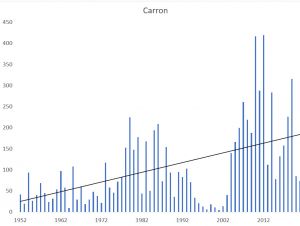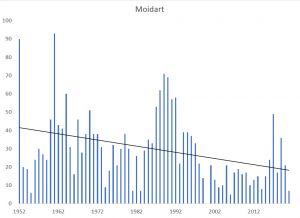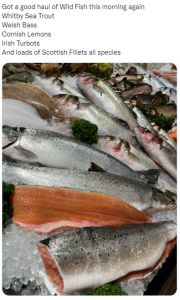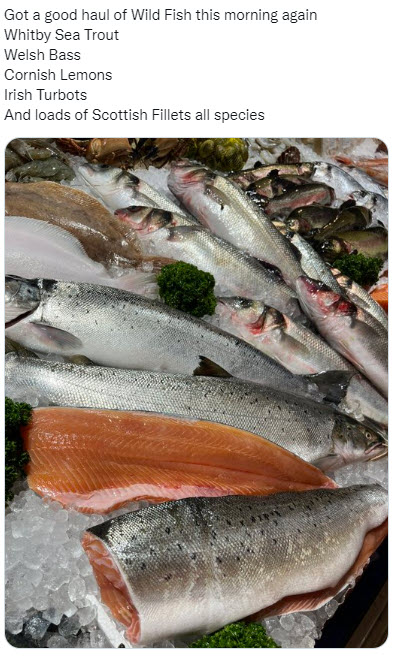Science: Well before the pandemic struck, Marine Scotland Science (MSS) launched a new stocking policy for salmon in Scottish rivers. Essentially, they only allowed conservation stocking of eggs or unfed fry. Stocking to boost rivers for angling was not allowed. At the time, I was invited to the Freshwater Fisheries Laboratory, Pitlochry to hear why the new policy was to be introduced. The message was clear, stocking does not work. In response, I pointed out that the catches from the River Caron seemed to suggest otherwise.
MSS told me that the much-improved catches were misleading. They were clear that had the restocking programme had not been carried out, stocks of salmon would have recovered on their own. At the same time, they said that although some of the fish caught could have been hatchery fish, there was no evidence that such fish would breed and maintain the stock. I was not convinced.
Firstly, why would the River Caron recover without help, when stocks in most other west coast rivers had failed to do so. According to MSS, stocks of wild salmon are impacted by sea lice from salmon farms (something else on which I believe MSS are wrong) and the River Caron empties into an area containing one of the largest aquaculture hubs in Scotland so how could the river recover when facing such pressures. Yet it has.
A few weeks ago, I related how I also attended a meeting organised by the River Caron Conservation Association (RCCA) in which they detailed research showing the DNA testing of the fish caught. This shows that the hatchery fish are in fact breeding in the river, something MSS said cannot happen.
A representative from MSS attended the meeting but asked no questions, since then nothing but silence. Now a video of the meeting has been posted on You Tube, which is essential viewing https://www.youtube.com/watch?v=jMUhy21wCV0
Whilst those with an opposing view to mine would say that as a strong proponent of the salmon farming industry, any comments I might make are not unexpected, however, it is worth considering the latest blog from Ian Gordon, the well-respected World Spey Casting Champion who runs a fishing school on the River Spey. In this he states:
“The film is an account, not only of how they quickly took the river back from the brink, but in the face of opposition from the scientific community (with other agendas), how, in the last 8 years they have quietly used science, particularly DNA sampling of hatchery fish to prove, when properly run in a particular river system, hatcheries can and do make a difference and can be targeted in the hatchery creating better genetic diversity within that population…The well-being of salmon in any river is all about numbers, “understanding the population” and having enough fish.”
He continues:
“At this moment in time we have so many rivers in Scotland where at one time there was a thriving salmon population, where now, due to apathy, neglect, extremely poor understanding of its required population and pathetically poor scientific input, there is nothing! A national disgrace and one where I truly believe all the perpetrators should never work another day in fisheries management. Their utter incompetence has cost Scotland dearly in jobs and potential income. A mass cull of this Incompetence is long overdue and required right now.”
He carries on:
“This should leave the door open on every river in Scotland for a complete overhaul of how we deal with this business, a complete change in how our rivers are managed, one where the views and opinions of people working on the ground (practical people) is not simply ignored, but, as they have done and been successful with on the Carron, taken on board and used to restore the salmon population. If anyone has an opinion different to this I’d love to hear on what grounds they have this as I can say with 100% degree of certainty, the present system has failed both the salmon and the communities relying on them.
Our sector should not be supporting 2500 jobs, it should be at least 5000! It shouldn’t provide £80-90m to the Scottish economy, it should be at least £250m.”
Finally, he says:
“No matter how others want to paint a negative picture or discredit this project, the facts remain, It has worked, there is a short term fix and they have the scientific evidence to back up their statements. The DNA sampling is ongoing. The 2014-year class shows the hatchery to be a significant contributor to the rivers’ salmon run. Another round of sampling will back up the first study.”
Certainly, Mr Gordon, a life-longer angler, has not pulled any punches. He is just as scathing about the way science is used as I am.
For me, it would seem to make sense that if salmon farming has been deemed to have a negative impact on wild fish, then the first thing to do is to examine the status of stocks in every river, which is what I have done since I embarked on this journey. Rod catches are used as an indication of the size of the stock and as MSS point out, this is about the only measure available for most Scottish rivers. Prior to the introduction of conservation gradings, the only analyses I encountered from official sources, in addition to the annual report of catches, was examination of spring, summer, and autumn stocks. The only data about (selected) individual rivers was published in the Fisheries Management Scotland Annual Review, and as I recently highlighted, the catches declared in the review appear to be very different to those listed in the official government statistics. Although salmon and grilse catches are collected separately, there appears to have been no analyses of whether they are subject to different trends, which we now know, from my latest peer-reviewed paper, is what has happened.
In the absence of any other data, I analysed the catches from all 109 Scottish fisheries districts for grilse, salmon, salmon & grilse and sea trout catches. I have not seen this done elsewhere.
The catch trend for the River Carron from 1952 to present is shown in the following graph:

It is clear that there have been major changes over the last twenty years following a series of major spate events in the river that washed away all the eggs and fry leaving very few breeding fish to sustain the river. It was only due to the stocking programme that the number of fish returning to the river has been significantly boosted. Catches have fallen away in more recent times, but they have fallen away in all rivers in Scotland including the Tweed, Spey, Tay and Dee. This is due to impacts that have occurred in the seas far away from the west coast.
Since 2015, MSS’s main effort has been directed at drawing up the conservation gradings for rivers and fishery districts. In the case of the River Carron, for the years 2017 to 2020, the river has been categorised as a Grade 2, except for one year when it was classified as a Grade 3. This means that the river has a 60-80% chance of meeting the conservation limit. For 2022, the River Carron remains a Grade 2 and thus MSS do not judge that the river should be mandatory catch and release and therefore should local regulations permit, anglers can kill the fish they caught.
The River Carron is grouped together in the North West Region – Kyle of Lochalsh to Ardnamurchan. This includes rivers in the Ailort, Arnisdale, Croe, Glenelg, Kilchoan, Morar, Moidart and Sheil fishery districts. Since 2017, most of these rivers are classified as Grade 3 rivers, a classification that is blamed on the presence of salmon farms. Long term readers of reLAKSation may remember that Salmon & Trout Conservation’s petition to the REC Committee which prompted the parliamentary inquiry was based on their (both misleading and wrong) claim that most west coast rivers were classified as Grade 3 due to the impacts of salmon farming.
One other district besides the Carron, stands out from the rest. This is the Moidart. In terms of conservation gradings, the two districts are very similar except in 2018 and 2019, the Moidart was downgraded to Grade 3 but like the Carron has subsequently been categorised as a Grade 2 river, which is what it remains in 2022. However, there is a major difference between the two districts, and this can be seen in the catch data trend, which unlike the Carron, has been in long-term decline. How can a fishery district that has seen catches fall away, be the same grading as a district which has increasing catches?

The conservation grading is calculated from the rod catch and therefore catches are extremely relevant. The catch is converted into stock size, and this is used to calculate the number of females and therefore the potential numbers of eggs produced. This is then compared to the estimated egg requirement of the area.
Clearly, the graphs show some year-to-year variation in catches, but this could be due to a variety of reasons including river flow and fishing effort. It does seem that when the overall trend is in decline, no river should be upgraded to a higher category. There appears to be no common sense in the gradings just basic maths. It is not surprising that the rivers are in such poor condition and its equally not surprising that the blame is directed to salmon farming, when clearly the science is poor.
I would like to end by highlighting two other districts in this area. Both the Morar and the Ailort have been consistently categorised as Grade 3 fisheries from 2017 to 2020 and likely in the years before that. However, in 2022, both districts were categorised as Grade 2. The Ailort shows a slight increasing trend, but this is influenced by an extremely high catch of grilse in 1989 of 400 fish, when typically, the catch was around 30 fish, which remains the typical catch. The Morar has been in decline over a long period. Why are these two districts suddenly upgraded. It makes no sense at all, especially when Scottish salmon rivers are said to be in crisis. It’s not surprising that Ian Gordon believes that the science and subsequent management has led to the demise of Scottish salmon fishing. It’s also not surprising that the scientists and representative organisations, who make up the main participants in the Wild Salmon Strategy don’t want any input on salmon management except from themselves. It is a complete mess.
Wild Fish: For the second time in seven years the angler’s representative organisation, Salmon & Trout Association (STA) has changed its name. In 2015, the organisation greenwashed it name to Salmon &Trout Conservation (STC) to deflect attention from the fact that its members catch and kill salmon & trout for sport. It has now changed its name to Wild Fish (although the official name is Wild Fish Conservation (WFC). They say that this is to better reflect their intention to be more robust, focussed and uncompromising but I suspect that the change has more to do with the fact that anglers have caught and killed more than 5.9 million fish for sport since records began and consequently there are so few salmon and trout left for the organisation to campaign for. They obviously feel the need to widen their scope to any fish.
However, they remain as blinkered as ever. Their publicity material begins: “Wild fish populations are collapsing. We destroy their freshwater habitats faster than anything else. Most of our rivers fail to reach ecological targets. Open-net salmon farming is ravaging wild salmon and sea trout. All fish are threatened by sewage, agricultural pollution, over-abstraction and barriers to migration.” I would suggest that they have omitted that the only thing ravaging wild salmon and sea trout are anglers but sadly, as in their previous incarnations, WFC are only interested in talking about their narrative not in hearing other explanations. Their Scottish ‘Director’ (although it’s unclear what organisation he is a director of) refuses point blank to engage in any discussion at all. He is so utterly convinced that salmon farming has decimated salmon and trout stocks that there can be no other explanation. This conviction resulted in STC being thrown out of the Missing Salmon Alliance. Its my view that if the organisation has such a conviction, it should be willing to stand up and defend its view against any other narrative. In the case of STC, it has always been a wall of silence.
In the past, STC Scotland has been a one-man band of their Scottish Director Andrew Graham Stewart. Even STC’s science specialist never contributed to the debate. Now it seems that there is a Scottish team with Rachel Mulrenan who is listed as Deputy Director Scotland and Matthew Palmer as Farmed Salmon Campaigns Manager. Neither of these new recruits have any contact details so presumably WFC don’t want anyone hearing anything that might undermine their narrative.
WFC’s latest campaign was aimed at the Wimbledon Tennis Tournament. They issued a press release, which the press ignored, saying that the championship stress on their website that it sources responsibly and that they work closely to ensure the very best for the environment. WFC say that the salmon served at Wimbledon comes from a farm which has been unable to control its sea lice and these lice infect and kill juvenile wild salmon and sea trout.
Wild Fish Director, Andrew Graham Stewart (although he is not listed as a director by Companies House and only listed as Scottish Director on the WFC website) says that for Wimbledon to serve farmed salmon, the product of what is, in many people’s opinion, a fundamentally unsustainable industry, shows bad judgement.
Its interesting that Mr Graham Stewart refers to many people’s opinion when he really means anglers (who only ever hear one side of the story) and a handful of NIMBYs. Clearly as farmed salmon is the most popular fish consumed in the UK and elsewhere, many other people have a much different opinion. It is also interesting that all WFC’s focus is on sea lice on salmon farms and not the impact on wild fish. This is because Mr Graham Stewart would be hard pressed to provide any real evidence that salmon farming is responsible for the declines of wild fish on the west coast. He simply relies on guilt by presence. Of course, if I m wrong, I would be more than happy to have that discussion with Mr Graham Stewart or any of his colleagues in Wild Fish. Of course, this will never happen, because they are all too scared to actually engage in a discussion that will show that they are wrong.
Nets: This week a Manchester fishmongers displayed some sea trout caught by netting off the coast at Whitby. By coincidence, the Missing Salmon Alliance has called for the closure of these nets as the number of salmonid fish returning to local rivers continues to experience a downward trend. They say that research has indicated that migratory salmonids are extremely vulnerable to inshore nets. However, whilst calling for the closure of the nets, they also highlight how the availability of more fish to angling will boost the local economy.

Their press release says that the Missing Salmon Alliance is a group of leading salmon conservation organisations fighting to reverse the devastating collapse of wild Atlantic salmon. What they really mean is that the reason they want to conserve these salmonids is so there are fish for anglers to catch for sport. If they were so bothered about conserving these fish, they would call for an immediate ban on all exploitation including catch and release and just not for the closure of those to whom they see as reducing their opportunities for sport.

